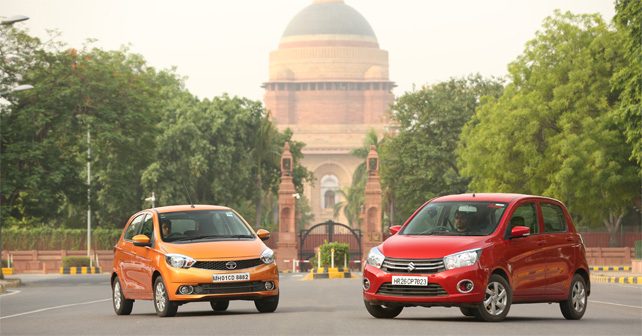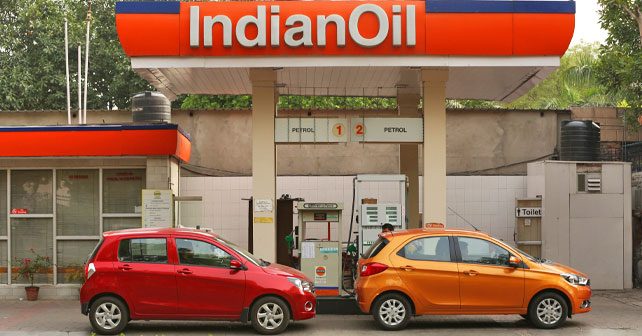If we love our diesels for offering the most miles per buck, we really ought to adore this duo. But, of these two, which should you choose?
The notion that diesels are unrefined and unreliable is a thing of the past. Modern diesels have revolutionized the passenger car space. In fact, most luxury cars sold in our market have a diesel engine under the hood. But those are large and very refined motors, what about the new-age small capacity diesel engines – how do they fare?
In order to find out, we lined up the diesel avatar of Tata’s new Tiago, with a 1.05-litre Revotorq diesel engine, against its archrival – the Maruti Suzuki Celerio with a 793cc diesel engine. So, let’s get those tiny turbos spooling!
Just twisting the key in the ignition of the Celerio is enough to let you know this isn’t your standard petrol hatchback. It has a long self-starter action complimented by quite the racket as the twin-cylinder engine comes to life. If there’s anything longer than firing up the Celerio’s diesel engine, it’s the fuel pump operation of the Tiago. This isn’t exactly getaway car material, as you have to wait for the fuel pump to complete its pre startup ritual before the self-starter is allowed to spin. So it’s best not to kill the engine at shorter traffic signals. Wait, doesn’t that go against fuel efficiency? Anyway, let’s brush past that for a moment. You see, on paper, the Tiago returns an ARAI claimed 27.28km/l – which is trumped only by the Celerio’s claimed efficiency of 27.62km/l.
In the real world, the Tiago diesel’s efficiency hovered around 20.6km/l – while the Celerio returned around 19.2km/l under similar conditions. So both these cars deliver where it matters most, fuel efficiency! Both provide a great value propositions, considering that these are the most affordable diesel cars in the country.
Fair enough then. But today’s car buyer is more demanding than buyers of yore. So merely offering an efficient car isn’t enough. They need to be well-rounded products that perform in other areas as well. And, on this account, Tata’s brand new Tiago seems to take the lead.
The Tiago comes with more equipment in the top-end TZ trim at a more affordable price of Rs. 5.54 lakhs, as compared to the top-of-the-line ZDi (O) variant of the Celerio diesel, which is priced at Rs. 5.90 lakhs (Ex-showroom, Delhi). In terms of kit, the Tiago gets a Harman Kardon sourced stereo with four speakers and four tweeters while featuring Bluetooth connectivity, the Juke car app, etc. I must add here that the system has really good sound quality for a car in its segment.
Both cars come with the usual equipment list, including power steering, power windows, electric ORVMs, a power socket, remote central locking, tilt adjustable steering wheel, height adjustable driver’s seat, rear defogger and wash wipe, dual front airbags, anti-lock brakes, etc. But the Tiago leaves the Celerio behind with electronic brake force distribution, corner stability control, rear parking sensors, cooled glovebox, follow-me-home headlamps, etc. Then there are little things like the rear wiper, which comes on when you engage reverse if the front wipers are working. While that is merely on the equipment front, the Tiago’s cabin also feels more upmarket with better quality plastics and overall design, leaving the Celerio to feel a bit dull in contrast. So, from a features standpoint, the Tiago wins. But how do these small capacity turbocharged diesel engines perform in the real world?
Well, the Celerio’s engine develops 46bhp at 3,500rpm and 125Nm of peak torque at 2,000 rpm. Naturally you have to work the five-speed manual gearbox to keep the turbo spooling close to 2,000rpm. There is a fair amount of turbo lag, but once past the 2,000rpm mark the Celerio diesel gets a move on. However, the car has seriously high NVH levels and a fair amount of diesel engine noise that makes its way inside the cabin.
The Tiago, on the other hand, feels more refined with much lower NVH levels. Sure, you can always tell that there’s a diesel engine under that bonnet but it sounds like a normal diesel car – and it isn’t nearly as intrusive. However, there are serious powertrain vibrations below 2,000rpm, so it’s best to keep this engine spinning above that mark. Apart from that, the Tiago’s cabin has better sound deadening – and with the Harmon Kardon audio cranked up you won’t even notice the motor.
The Tiago’s 1,047cc, three cylinder engine not only feels more refined but comes with more power too – 68bhp at 4,000rpm and 140Nm of peak torque spread between 1,800-3,000rpm. As a result, the Tata Tiago offers better drivability and performance. It’ll happily cruise at 140km/h, while the Celerio runs out of steam after 135km/h. That said, the lighter Celerio diesel (at 900kgs) feels faster during in-gear acceleration than the heavier Tiago diesel (1,080kgs) – so long as you keep the Maruti in the meat of the powerband. The Tiago, however, feels better to drive overall than the Celerio.
The Tata also has a more comfortable ride and excellent brakes. Unfortunately for the Celerio, gone are the somewhat positive handling traits of the petrol car – the diesel model feels heavier and is quite dull on the handling front.
All said and done, it’s the Tiago that has the more upmarket interiors, more refined powertrain and lengthy equipment list, which brings a sense of desirability to the segment. And so it’s clear that the Tiago is the winner here.
However, that’s not the end of the story. The Tiago’s engine temperature kept varying between one and three bars depending on the outside temperature. This means that the engine doesn’t have very good thermodynamics, which in turn puts a question mark on the longevity of the motor. Come to think of it, we need to gauge the lifespan of these new small diesel engines because they simply haven’t been around for that long.
The Tata, though, has a few more minor issues. The degree to which the air vents can be adjusted was limited, so I almost always had too much air coming my way even at the lowest fan speed. The front bottle holders can’t hold one litre bottles and access isn’t easy. The power window switches don’t fall easily to hand and the boot is much too narrow thanks to those wheel arches.
So, in conclusion, Tata needs to iron out some basic issues to make the Tiago as good as it should be. Come on Tata, you’re almost there...
- Maruti Suzuki Celerio ZDi (O) diesel
- Tata Tiago TZ Diesel
Engine: 793cc / In-line 2-Cylinders / 8 Valves / Turbocharged
Fuel: Diesel
Transmission: 5-Speed Manual / Front Wheel Drive
Power: 46bhp @ 3,500rpm
Torque: 125Nm @ 2,000rpm
Price: Rs. 5.90 lakhs (Ex-showroom, Delhi)
Engine: 1,047cc / In-line 3-cylinders / 12 valves / Turbocharged
Fuel: Diesel
Transmission: 5-Speed Manual / Front Wheel Drive
Power: 68bhp @ 4,000rpm
Torque: 140Nm @ 1,800-3,000rpm
Price: Rs. 5.54 lakhs (Ex-showroom, Delhi)






























Write your Comment